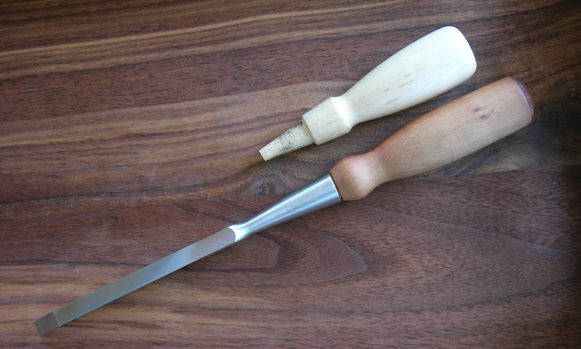MarcW
Established Member
Hi all,
The 5/16 mortice chisel is a good tool. If only the handle was a tad longer. My praw grabs it with the little finger around the steel. That was not comfortable a grip. It was like holding something to thin in your hand. As I got a lathe this summer I turned a handle a bit longer. It felt fine.

Now as I made a two inch deep mortise some days ago, the handle broke off as I levered out the chips of the bottom. I thought it was due to the pearwood I used for the handle... Meanwhile I had ordered two other LN chisels amongst which the one inch bench chisel. Its handle is a tad bigger, much better fitting my hand and I stuck it into the mortice chisel. Hm, guess now! What is a major advantage if you want to change the handle, is a drawback the moment you make mortises. Imagine, the movement you make in order to put off the handle - tapping it on the bench - is in principle the same you make when levering out chips or cleaning bottoms. Levering forth and back, the handle loosens. Now if I knew Maine hornbeam would resist breaking off; I'd epoxy it to the socket, but the past experiences with pearwood warns me to do so. Did you experience this and what did you do?
Merry Christmas
The 5/16 mortice chisel is a good tool. If only the handle was a tad longer. My praw grabs it with the little finger around the steel. That was not comfortable a grip. It was like holding something to thin in your hand. As I got a lathe this summer I turned a handle a bit longer. It felt fine.

Now as I made a two inch deep mortise some days ago, the handle broke off as I levered out the chips of the bottom. I thought it was due to the pearwood I used for the handle... Meanwhile I had ordered two other LN chisels amongst which the one inch bench chisel. Its handle is a tad bigger, much better fitting my hand and I stuck it into the mortice chisel. Hm, guess now! What is a major advantage if you want to change the handle, is a drawback the moment you make mortises. Imagine, the movement you make in order to put off the handle - tapping it on the bench - is in principle the same you make when levering out chips or cleaning bottoms. Levering forth and back, the handle loosens. Now if I knew Maine hornbeam would resist breaking off; I'd epoxy it to the socket, but the past experiences with pearwood warns me to do so. Did you experience this and what did you do?
Merry Christmas




